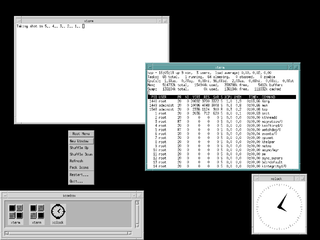
AIX is a series of proprietary Unix operating systems developed and sold by IBM for several of its computer platforms.
Poplog is a reflective, incrementally compiled software development computer programming integrated development environment and system platform for the programming languages POP-11, Common Lisp, Prolog, and Standard ML. It was created originally in the United Kingdom for teaching and research in artificial intelligence, at the University of Sussex, and later marketed as a commercial package for software development, teaching, and research. It was one of the initiatives supported for a time by the UK government-funded Alvey Programme.

SPSS Statistics is a statistical software suite developed by IBM for data management, advanced analytics, multivariate analysis, business intelligence, and criminal investigation. Long produced by SPSS Inc., it was acquired by IBM in 2009. Versions of the software released since 2015 have the brand name IBM SPSS Statistics.

In computing, Motif refers to both a graphical user interface (GUI) specification and the widget toolkit for building applications that follow that specification under the X Window System on Unix and Unix-like operating systems. The Motif look and feel is distinguished by its use of rudimentary square and chiseled three-dimensional effects for its various user interface elements.

A/UX is a Unix-based operating system from Apple Computer for Macintosh computers, integrated with System 7's graphical interface and application compatibility. It is Apple's first official Unix-based operating system, launched in 1988 and discontinued in 1995 with version 3.1.1. A/UX requires select 68k-based Macintosh models with an FPU and a paged memory management unit (PMMU), including the Macintosh II, SE/30, Quadra, and Centris series.
Presentation Manager (PM) is the graphical user interface (GUI) that IBM and Microsoft introduced in version 1.1 of their operating system OS/2 in late 1988.
POP-11 is a reflective, incrementally compiled programming language with many of the features of an interpreted language. It is the core language of the Poplog programming environment developed originally by the University of Sussex, and recently in the School of Computer Science at the University of Birmingham, which hosts the main Poplog website.

NewWave is a discontinued object-oriented graphical desktop environment and office productivity tool for PCs running early versions of Microsoft Windows. It was developed by Hewlett-Packard and introduced commercially in 1988. It was used on the HP Vectras and other IBM compatible PCs running Windows.

SAS is a statistical software suite developed by SAS Institute for data management, advanced analytics, multivariate analysis, business intelligence, criminal investigation, and predictive analytics. SAS' analytical software is built upon artificial intelligence and utilizes machine learning, deep learning and generative AI to manage and model data.
JMP is a suite of computer programs for statistical analysis developed by JMP, a subsidiary of SAS Institute. It was launched in 1989 to take advantage of the graphical user interface introduced by the Macintosh operating systems. It has since been significantly rewritten and made available also for the Windows operating system. JMP is used in applications such as Machine Learning, Six Sigma, quality control, design of experiments, as well as for research in science, engineering, biotechnologies, and social sciences.

In computing, a shell is a computer program that exposes an operating system's services to a human user or other programs. In general, operating system shells use either a command-line interface (CLI) or graphical user interface (GUI), depending on a computer's role and particular operation. It is named a shell because it is the outermost layer around the operating system.
The Cross-industry standard process for data mining, known as CRISP-DM, is an open standard process model that describes common approaches used by data mining experts. It is the most widely-used analytics model.
Caldera OpenLinux (COL) is a defunct Linux distribution. Caldera originally introduced it in 1997 based on the German LST Power Linux distribution, and then taken over and further developed by Caldera Systems since 1998. A successor to the Caldera Network Desktop put together by Caldera since 1995, OpenLinux was an early "business-oriented distribution" and foreshadowed the direction of developments that came to most other distributions and the Linux community generally.

The Common Open Software Environment (COSE) was an initiative formed in March 1993 by the major Unix vendors of the time to create open, unified operating system (OS) standards.

KXEN was an American software company which existed from 1998 to 2013 when it was acquired by SAP AG.

SPSS Inc. was a software house headquartered in Chicago and incorporated in Delaware, most noted for the proprietary software of the same name SPSS. The company was started in 1968 when Norman Nie, Dale Bent, and Hadlai "Tex" Hull developed and started selling the SPSS software. The company was incorporated in 1975, and Nie served as CEO from 1975 until 1992. Jack Noonan served as CEO from 1992 until the 2009 acquisition of SPSS Inc. by IBM. In 2008 SPSS Inc. had sales of US$302.9 million and over 250,000 customers.
Rexer Analytics’s Annual Data Miner Survey is the largest survey of data mining, data science, and analytics professionals in the industry. It consists of approximately 50 multiple choice and open-ended questions that cover seven general areas of data mining science and practice: (1) Field and goals, (2) Algorithms, (3) Models, (4) Tools, (5) Technology, (6) Challenges, and (7) Future. It is conducted as a service to the data mining community, and the results are usually announced at the PAW conferences and shared via freely available summary reports. In the 2013 survey, 1259 data miners from 75 countries participated. After 2011, Rexer Analytics moved to a biannual schedule.
Deep Learning Studio is a software tool that aims to simplify the creation of deep learning models used in artificial intelligence. It is compatible with a number of open-source programming frameworks popularly used in artificial neural networks, including MXNet and Google's TensorFlow.












